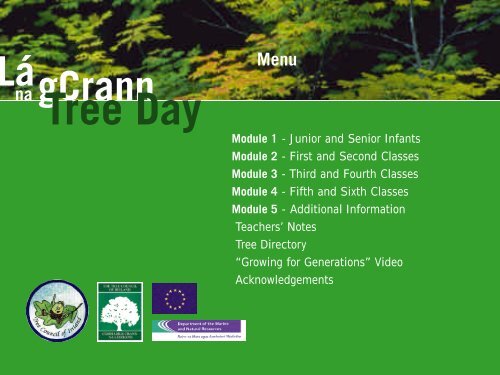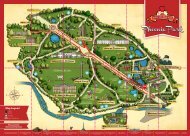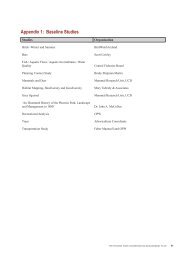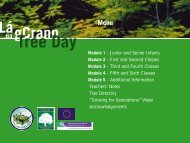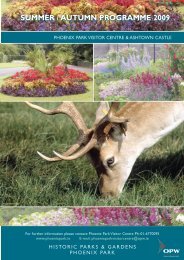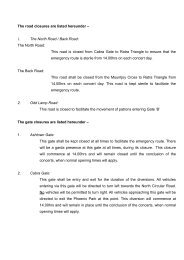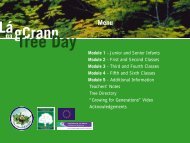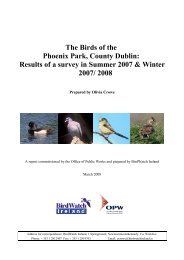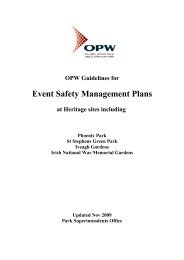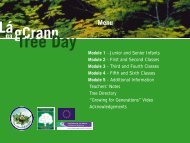Worksheets for 3rd & 4th Class - Phoenix Park
Worksheets for 3rd & 4th Class - Phoenix Park
Worksheets for 3rd & 4th Class - Phoenix Park
- No tags were found...
Create successful ePaper yourself
Turn your PDF publications into a flip-book with our unique Google optimized e-Paper software.
á<br />
na gCrann<br />
Tree Day<br />
Menu<br />
Module 1 - Junior and Senior Infants<br />
Module 2 - First and Second <strong>Class</strong>es<br />
Module 3 - Third and Fourth <strong>Class</strong>es<br />
Module 4 - Fifth and Sixth <strong>Class</strong>es<br />
Module 5 - Additional In<strong>for</strong>mation<br />
Teachers’ Notes<br />
Tree Directory<br />
“Growing <strong>for</strong> Generations” Video<br />
Acknowledgements
What is a Tree?<br />
A tree is a tall woody plant that can live <strong>for</strong> many<br />
years.<br />
Why is a tree so tall?<br />
A tree is tall <strong>for</strong> two reasons.<br />
✱ A tree grows taller and wider every year.<br />
Plants such as daffodils and grass die<br />
back every year after flowering so they<br />
will never grow tall like a tree.<br />
✱ A tree has a strong woody<br />
trunk which is able to hold<br />
up the branches.<br />
A tall flower such as a<br />
sunflower has to be tied up<br />
and supported to stop the<br />
wind blowing it over. This is<br />
because the sunflower does not have<br />
a woody stem.<br />
How old is a tree?<br />
How old is a tree? You can tell the age of a tree by counting the<br />
rings. There is one ring <strong>for</strong> each year.<br />
Q How old is tree number 1?<br />
Q How old is tree number 2? 1<br />
2<br />
Trees –Module Three – 1
❋<br />
How a Tree Lives<br />
The leaves of the tree make food. They use sunlight as energy <strong>for</strong> this.<br />
Food is only made during the day.<br />
The food moves down the tree through the bark to the roots.<br />
❋<br />
Water<br />
◗<br />
Food<br />
❋<br />
◗<br />
Water<br />
❋<br />
Food<br />
◗<br />
❋<br />
Water<br />
❋<br />
Like all plants, trees need water to live. Water is taken from the soil by the roots.<br />
It moves up the tree to the leaves through the wood of the trunk.<br />
❋<br />
Water<br />
Trees –Module Three – 2
Light and Water<br />
This experiment shows that plants<br />
need light and water.<br />
What you need<br />
Four healthy plants, <strong>for</strong> example busy lizzies<br />
or potatoes<br />
A black plastic bag<br />
Label the plants 1, 2, 3 and 4.<br />
What you do<br />
✱ Leave Plant 1 on a window sill where it will get light.<br />
Water it whenever it needs it.<br />
✱ Place Plant 2 on the window<br />
sill beside plant 1.<br />
Do not water it at all.<br />
✱ Water Plant 3 well. Then put it<br />
in the black plastic bag.<br />
Seal the bag tightly.<br />
1<br />
✱ Leave Plants 1, 2 and 3 <strong>for</strong><br />
three weeks.<br />
✱ Use Plant 4 to show that water moves up the plant from<br />
the roots to the leaves.<br />
✱ Cut the top off Plant 4. Lie the pot on its side over newspaper.<br />
What happens to the part that has been cut off?<br />
1<br />
3<br />
2<br />
2<br />
4<br />
3<br />
_____________________________________<br />
Is there moisture coming out of it?<br />
___________________<br />
Trees –Module Three – 3
Light and Water<br />
After three weeks, look at Plants 1, 2 and 3.<br />
Place a tick (✔) on the chart to show the condition of each plant.<br />
Healthy Yellow Dying Dead<br />
Plant 1<br />
Plant 2<br />
Plant 3<br />
Can you explain...<br />
What happened to Plant 1?<br />
__________________________________________<br />
1<br />
Why? _________________________________________________<br />
What happened to Plant 2?<br />
__________________________________________<br />
2<br />
Why? _________________________________________________<br />
What happened to Plant 3?<br />
3<br />
__________________________________________<br />
Why? _________________________________________________<br />
Trees –Module Three – 4
Types of Trees<br />
Some trees lose their leaves every autumn.<br />
The leaves change colour be<strong>for</strong>e they fall off the tree.<br />
A tree that loses its leaves every autumn is a deciduous tree.<br />
In September and October, it is easy to recognise deciduous trees.<br />
Some trees, such as the holly<br />
and the yew, have green<br />
leaves all year round.<br />
These are evergreen trees.<br />
Holly<br />
Oak<br />
Some evergreen trees have small<br />
needle-like leaves and cones.<br />
These are conifers.<br />
Spruce<br />
Trees –Module Three – 5
Types of Trees<br />
To Do<br />
Choose a deciduous<br />
tree in your school<br />
grounds, or near<br />
your school.<br />
Ash<br />
Oak<br />
Birch<br />
What is the name of the tree?<br />
_______________________<br />
In autumn, you can observe the leaves and fruits.<br />
In winter, you can observe bark, twigs and buds.<br />
In spring/early summer, you can observe new leaves and flowers.<br />
These may be in the <strong>for</strong>m of catkins, depending on the species.<br />
This is a leaf from an evergreen tree.<br />
What tree is it from?<br />
_____________________<br />
Conifers<br />
These are very common in cold countries<br />
where there is a lot of snow in winter.<br />
The trees are shaped like this so that a heavy<br />
fall of snow does not break the branches.<br />
Name a country in Northern Europe with<br />
a cold climate where these trees grow.<br />
Spruce<br />
Trees –Module Three – 6
Seeds<br />
How new trees grow<br />
Trees grow from seeds. They need light and space to<br />
grow, so they must get away from under the parent tree.<br />
This happens in two ways in the natural environment.<br />
• The wind blows the seeds away from the parent tree.<br />
These seeds have wings to help them fly.<br />
• Animals and birds take the seeds away from the<br />
parent tree. They collect the seeds to eat but<br />
sometimes they don’t eat them all. The ones that are<br />
left may grow into new trees.<br />
Sycamore seed<br />
Ash seed<br />
Pine seeds<br />
Jays collect<br />
acorns.<br />
Mice collect beech<br />
nuts and chestnuts.<br />
Squirrels collect<br />
hazel nuts.<br />
Some seeds must be eaten be<strong>for</strong>e they can<br />
grow. These are the very hard seeds in the<br />
centre of a juicy fruit such as elder,<br />
blackberries and haws.<br />
Elderberries<br />
Blackberry<br />
Haws<br />
These hard seeds are not digested when the bird eats the<br />
fruit. The seed grows from the bird’s droppings.<br />
Trees –Module Three – 7
Field Trip<br />
Go out in September or early October to look at trees and to collect seeds.<br />
Choose a tree to study. Look at the tree.<br />
Q Is it deciduous or evergreen tree?<br />
_______________________________<br />
Q How do you know?<br />
____________________________________________________________<br />
Q Name the tree<br />
___________________________________________<br />
Q What colour are the leaves?<br />
___________________________________<br />
Q Are the leaves…<br />
Broad?<br />
Narrow?<br />
Stand away from<br />
the tree.<br />
Sketch the<br />
shape of<br />
the tree<br />
in this<br />
space.<br />
Trees –Module Three – 8
Field Trip<br />
Q Is this tree a good shape <strong>for</strong> a heavy coat of snow?<br />
_____________<br />
Why?<br />
_________________________________________________<br />
Q Has the tree seeds? Yes No<br />
Describe the seeds. (Colour, shape, size, hard / soft )<br />
Colour<br />
_______________________________<br />
Shape<br />
_______________________________<br />
Size<br />
_______________________________<br />
Are they… hard? soft?<br />
Q How do you think the seeds are scattered from the tree?<br />
By wind.<br />
By wildlife.<br />
Take some seeds back to class afterwards and plant them..<br />
Trees –Module Three – 9
Growing Trees<br />
Trees grow from seeds.<br />
Seeds are <strong>for</strong>med by a tree in autumn.<br />
Seeds develop from flowers.<br />
Seeds do not grow as soon as they reach a piece of<br />
clear ground away from their parent tree.<br />
If they did, the cold weather in winter would kill<br />
the new little tree.<br />
Instead, seeds start to grow in spring.<br />
This is called germination.<br />
The seeds from oak, beech, horse chestnut,<br />
sycamore and hazel begin to grow the spring<br />
after they were <strong>for</strong>med.<br />
Some seeds need two winters in the ground be<strong>for</strong>e they will<br />
grow. Holly and ash trees have seeds like this.<br />
Sowing a seed<br />
Q What is the name of the seed you are going to sow?<br />
_________________<br />
Q Is it a seed that is carried away <strong>for</strong> food, or is it carried away by the wind?<br />
Food<br />
Carried by wind<br />
Q Will it germinate (begin to grow) the first spring or the second spring<br />
after it was <strong>for</strong>med by the parent tree?<br />
First Spring<br />
Second Spring<br />
Trees –Module Three – 10
Planting a Seed<br />
Some seeds will germinate the first spring after they were <strong>for</strong>med.<br />
What you need<br />
What you do<br />
seeds (oak, chestnut, beech, sycamore, hazel)<br />
a flower pot or clean milk carton<br />
horticultural sand<br />
potting compost (preferably peat-free<br />
to save our bogs)<br />
clear plastic to cover the pot<br />
a label<br />
✱ Wash the milk container well and open it out fully.<br />
✱ Make five or six holes in the bottom of it with a pencil.<br />
The holes are <strong>for</strong> drainage.<br />
✱<br />
✱<br />
✱<br />
✱<br />
✱<br />
✱<br />
Put 3 cm of horticultural sand in the container.<br />
Fill it to the top with potting compost.<br />
Mix well.<br />
Insert a seed in the compost to its own depth.<br />
Moisten the compost with a little water.<br />
Label the container with your name, the name of the<br />
seed and the date.<br />
Leave the container on a cold north-facing window sill in the classroom or leave<br />
it outside in a sheltered place.<br />
Cover it with clear plastic if you<br />
leave it outside. This will keep the<br />
compost moist and stop mice from<br />
eating your seed.<br />
Take your container into the classroom in<br />
spring when the seed begins to grow. Leave<br />
it on the window sill where it will get light.<br />
Trees –Module Three – 11
Planting a Seed<br />
Some seeds that will not germinate until the second spring after they were<br />
<strong>for</strong>med.<br />
What you need<br />
What you do<br />
seeds (holly, ash, rowan) It is a good idea<br />
to have a handful of seeds.<br />
a flower pot or clean milk carton<br />
horticultural sand<br />
clear plastic to cover the pot<br />
a label<br />
✱<br />
✱<br />
✱<br />
Mix the seeds with 4 times their volume of sand.<br />
Put the mixture into the flower pot or carton.<br />
Cover the pot with clear plastic.<br />
✱ Label the pot with your name, the name of the<br />
seeds and the date.<br />
✱ Leave it outside where it will get frost.<br />
(The seeds will not germinate if they do not<br />
get frost.)<br />
✱ In March, or when the ground is not<br />
too hard, bury the whole pot in the<br />
ground so that it won’t dry out.<br />
✱ Mark the spot where you buried it.<br />
✱ Dig it up the following spring and the<br />
seedlings are ready <strong>for</strong> sowing.<br />
Trees –Module Three – 12
Trees and Wildlife<br />
Birds, animals and insects use trees <strong>for</strong> three reasons.<br />
☞ They can find their food there.<br />
☞ They can have their homes there.<br />
☞ They can rest and sleep there.<br />
All parts of the tree are used in these ways.<br />
Food<br />
The leaves, fruits and seeds of a tree are food <strong>for</strong><br />
caterpillars, greenflies, squirrels, blackbirds and mice.<br />
Caterpillars eat green ___ ___ ___ ___ ___ ___ .<br />
Squirrels eat ___ ___ ___ ___ ___ ___ ___ ___ ___ .<br />
Greenflies suck ___ ___ ___ ___<br />
___ ___ ___ ___ ___ ___.<br />
Mice eat ___ ___ ___ ___ ___ ___ which they find under the tree.<br />
Red ___ ___ ___ ___ ___ ___ ___ are food <strong>for</strong> blackbirds.<br />
Creatures that feed on parts of<br />
a tree are called herbivores.<br />
Word Bank<br />
hazel nuts leaves<br />
acorns berries<br />
leaf juices<br />
Trees –Module Three – 13
Trees and Wildlife<br />
Some birds, animals and other wildlife<br />
come to trees to eat the herbivores.<br />
Animals that eat other animals are called<br />
carnivores.<br />
Pine martens<br />
eat squirrels.<br />
Robins eat<br />
caterpillars.<br />
Make a list of all the carnivores you can see here.<br />
1 _______________________________<br />
2 _______________________________<br />
3 _______________________________<br />
4 _______________________________<br />
5 _______________________________<br />
Carnivores are animals that eat<br />
other animals.<br />
Owls eat mice.<br />
Spiders<br />
eat<br />
greenflies.<br />
Sparrowhawks eat blackbirds.<br />
Trees –Module Three – 14
Trees and Wildlife<br />
Homes<br />
Birds such as<br />
robins, thrushes<br />
and magpies build<br />
nests in trees.<br />
Blue tits, bumble bees<br />
and bats live in holes<br />
in the trunk.<br />
Slugs and spiders live in<br />
cracks in the bark.<br />
Mice and beetles make<br />
burrows under the roots.<br />
Trees –Module Three – 15
Trees and Wildlife<br />
Resting and Sleeping<br />
Rooks and starlings crowd<br />
together in flocks on the<br />
branches of trees to keep<br />
warm in winter.<br />
Pigeons sleep in trees at<br />
night and go off to fields to<br />
feed during the day.<br />
Snails rest under the bark of<br />
the tree during the day. They<br />
feed on plants and grasses on<br />
the ground at night.<br />
Trees –Module Three – 16
Food Chains<br />
Fill in the links in following food chains.<br />
Then make your own food chain.<br />
Remember that humans are part of a<br />
food chain.<br />
Owl<br />
Caterpillar<br />
Acorn<br />
Oak Leaf<br />
Blackbird<br />
Blackberry<br />
Trees –Module Three – 17
Trees and People<br />
Timber<br />
Timber from trees is used to make furniture.<br />
List four things in your classroom made from timber.<br />
1 _________________________<br />
2 _________________________<br />
3 _________________________<br />
4 _________________________<br />
Draw one of these things in the space.<br />
List four things in your home made from timber.<br />
1 _________________________<br />
2 _________________________<br />
3 _________________________<br />
4 _________________________<br />
Draw one of these things in the space.<br />
Trees –Module Three – 18
Trees and People<br />
Paper, Cardboard, Rubber<br />
Timber can be pulped and made into paper and cardboard.<br />
Name two things made from paper.<br />
1 _____________________________________<br />
2 _____________________________________<br />
Name two things made from cardboard.<br />
1 _____________________________________<br />
2 _____________________________________<br />
Rubber is made from the juice or sap of the rubber tree which grows in tropical<br />
countries. When this hardens, it becomes waterproof.<br />
Name two things made from rubber.<br />
1 _____________________________________<br />
2 _____________________________________<br />
Turpentine and maple syrup are also the juices or sap of trees.<br />
Trees –Module Three – 19
Trees and People<br />
Do you know…<br />
?<br />
?<br />
?<br />
?<br />
or can you find out?<br />
?<br />
?<br />
?<br />
Q What happens to paper when it gets wet?<br />
_______________________________________<br />
_______________________________________<br />
Q What happens to a rubber ball when it is dropped?<br />
_______________________________________<br />
_______________________________________<br />
Q What happens to timber when it is left outside<br />
in the rain <strong>for</strong> long time?<br />
_______________________________________<br />
_______________________________________<br />
Q Why do we paint wooden windows?<br />
_______________________________________<br />
_______________________________________<br />
Trees –Module Three – 20
Word Search<br />
Find ten carnivores in this word search.<br />
b l r o b i n d k h<br />
a a k f o x x e e e<br />
t b d f w a o k s d<br />
s n a g e r w x t g<br />
n a i s e a l s r e<br />
a b a d g e m v e h<br />
i g i h o s h o l o<br />
l p n p y n e a o g<br />
s p i g e r a t i t<br />
b l u e t i t s m p<br />
Trees –Module Three – 21
Crossword<br />
Test your knowledge!<br />
1 2 3 4<br />
5 6<br />
7<br />
8<br />
9 10<br />
11<br />
Across<br />
1 A member of the snail family without a shell.<br />
2 These are found on conifer trees.<br />
5 Conkers are the seeds of this tree.<br />
7 This changes colour and falls in autumn.<br />
9 This bird eats spiders and has a red breast.<br />
11 This bird is a carnivore.<br />
Down<br />
1 The seeds of this tree are known as helicopters.<br />
2 This tree is ∆ shaped to withstand being covered with snow.<br />
3 Squirrels eat many of these.<br />
4 The fruit of the blackthorn is called a _ _ _ _ .<br />
6 All new trees grow from these.<br />
8 They sting and they live together in colonies in the ground.<br />
10 An acorn grows into this.<br />
Trees –Module Three – 22


